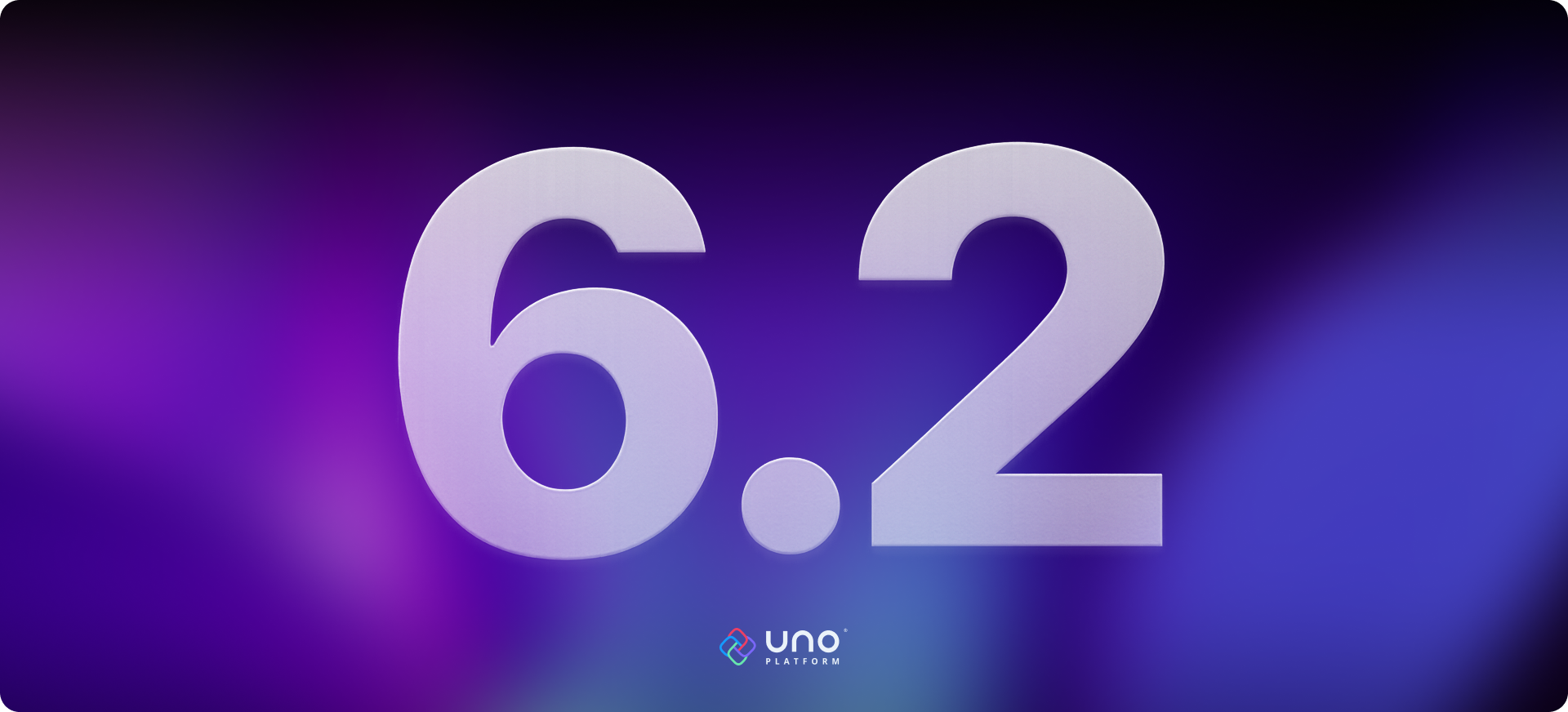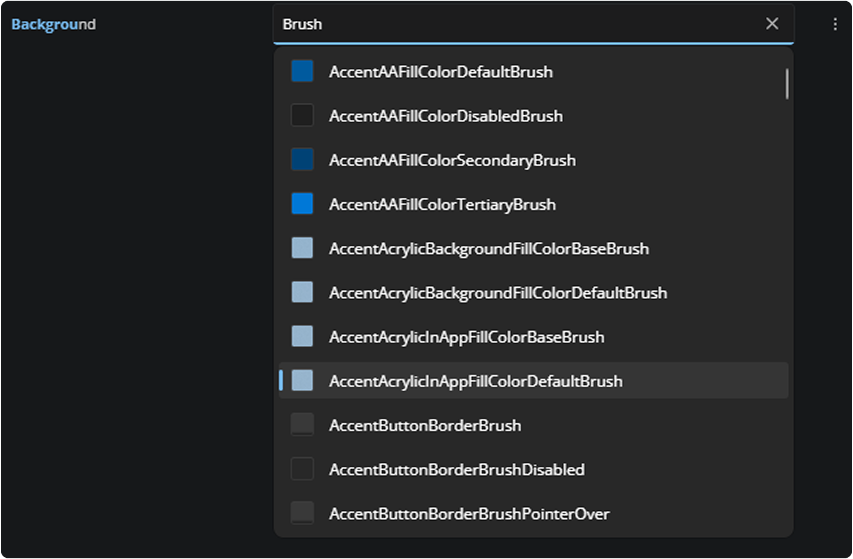Save 20% on Uno Platform Studio Pro until Dec 22 at 11:59 PM.- use code 68WVVMRQ at checkout.
Uno Platform 6.2: Smoother, Faster, Everywhere
It’s only been five weeks since 6.1, and we’re already back with Uno Platform 6.2. That’s the cadence we’re aiming for: focused releases that solve real issues you’ve flagged.
This cycle closes nearly 100 issues raised by the community and enterprise teams, and brings another round of improvements to Hot Design. The result: smoother workflows, faster iteration, better reliability across all platforms.

Let’s first look at the changes made to the core Uno Platform open-source project, and then we’ll dig into the premium tooling – Uno Platform Studio and Hot Design.
Table of Contents
Uno Platform 6.2 Highlights
6.2 isn’t just about polish, it’s packed with fixes, enhancements, and thoughtful improvements, many inspired directly by your feedback.
Here are just a few highlights, including some behind-the-scenes updates:
Skia WebAssembly improvements
We listened to your feedback and addressed two common issues with Skia WebAssembly.
- First, for high-DPI screens some users were experiencing white borders on the right and bottom side of the screen, which was caused by browser size rounding. We now use precise float values so those borders are gone.
- Previously, it was not possible to use the browser keyboard shortcut (Ctrl, +/-) to adjust scaling in Skia WebAssembly applications. We heard your feedback and enabled browser zoom (Ctrl +/-) for Skia WebAssembly apps. Accessibility and usability both get a boost with this one.
Skia Canvas Element improvements
Starting from our 6.0 release, we announced Skia as our default rendering engine. In this new release, we’ve updated our SKCanvasElement API to make its types available on all Uno targets, enabling compilation on both our native and Skia renderers.
While the API is available everywhere, SKCanvasElement is only functional when running the Skia renderer. To determine if the SKCanvasElement can be used on the running environment, developers should perform a runtime check using the new static method: SKCanvasElement.IsSupportedOnCurrentPlatform().
In addition to providing ease of use for developers, this change is especially beneficial for third-party library authors who want to support both Skia and native rendering in a single package.
For more details, check out the documentation and sample code.
WebView2 alignments
The WebView2 control now lines up with WinUI in both lifecycle and behavior, making it easier to reuse the same business logic across platforms without surprises. This work came through two PRs from Lester Botello, huge thanks for the contribution.
ListView selection improvements
An issue involving TabView selection discrepancies led us to investigate the selection logic of the underlying ListView control. In this process, we were able to significantly simplify the item container to index assignment logic, hereby removing a lot of complexity while achieving improved correctness for all list manipulation scenarios – win-win!
RequestedTheme reliability
For a long time, we supported setting the application theme via the root element of the application. However, thanks to an issue reported by our clients we found out that the theme is not properly applied when it is set before the first window initially loads. We fixed this problem and even ensured that secondary windows don’t override the explicit theme set by the initial app window, so multiwindow applications will have consistent theming.
RatingControl update
We have updated the rating control to be aligned with the latest WinUI sources, ensuring it includes all the latest enhancements. This update also included various bugfixes, including a change that ensures the individual stars within the control are correctly vertically centered.
Uno Platform Studio & Hot Design
Now that we’ve covered improvements to the core open-source offering, lets turn to the premium tooling. In this release, the updates to Uno Platform Studio focused on making template editing more intuitive and powerful. We improved the support for template editing, working with template selectors in Hot Design and improving the Color Editor experience.
These improvements are all about helping you move faster, design smarter, and build better across every platform.
Edit Template with List Item inside Hot Design
Previously, when editing a DataTemplate in Hot Design, the DataContext was always set to the first item in the bound list. This worked for simple cases but made it hard to test how the template looked with other items.
With this release, that’s no longer a limitation. You can now edit a template directly from any item in the list. Just hover over the item you want to work with, you’ll see a dashed border appear. Right-click, select Edit ItemTemplate, and Hot Design will open the template editor with that specific item as the DataContext.
It’s a small change but with a big impact: more control, better testing, and a smoother design experience.
Continuing the example above, once inside the editor, you’re not limited to the single item you picked. A pager at the bottom lets you move through other items in the ItemsSource so you can validate how the template behaves across different data.
Template Selector
Hot Design now fully supports DataTemplateSelector. Whether you’re creating a new selector or using an existing one, all the DataTemplates it references are now available for editing directly in the template editor.
This makes it much easier to handle scenarios where templates vary based on item type or state.
Live color previews
Color management shouldn’t be guesswork. Now, anytime you pick a color in Hot Design, whether it is background, border, or foreground etc, you now see a live preview before you commit. No more blind clicks or trial and error loops. Just pick, preview, and move on with confidence.

This progression shows how Hot Design has moved from editing templates in a single, fixed context to supporting item-specific editing, template selectors, and better visual feedback, making it more practical for real-world UI design.
Edit your app live with Hot Design
Run your Uno Platform project, toggle on Hot Design,
and start editing your UI instantly — no rebuilds, no restarts.
*You’ll need to create a free account to use Hot Design.
Documentation Updates
We’ve expanded and updated our documentation to make your development workflow smoother. You’ll now find clearer troubleshooting steps for common issues like memory leaks, missing libraries, and migration challenges.
Publishing guidance has also been refreshed, with updated instructions for macOS and Azure Static Web Apps.
Contributing
There are plenty of ways to contribute to Uno Platform. You can fix bugs, work on performance improvements, help fill in missing documentation, or even pick up a good first issue. Every contribution helps move the platform forward, no matter the size. Check out our GitHub repo to get started.
You’re also welcome to join the conversation with our community and core developers over on Discord.
Special shout-out to @Harsherr and @qin-guan who made their first contributions!
Get Started with Uno Platform 6.2
Update your project to the latest Uno.Sdk, and fire up your app. Enjoy faster iterations, improved reliability, and a smoother design-time experience.
Get Started